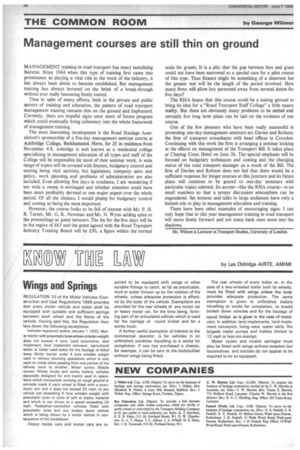ERIDM by Les Oldridge At ATE. AMIMI
Page 100

If you've noticed an error in this article please click here to report it so we can fix it.
Wings and Springs
REGULATION 10 of the Motor Vehicles (Construction and Use) Regulations 1966 provides that every motor vehicle and trailer shall be equipped with suitable and sufficient springs between each wheel and the frame of the vehicle. Having said this, the Regulation then lays down the following exceptions:
Vehicles registered before January 1 1932; Motor tractor with pneumatic tyres whose unladen weight does not exceed 4 tons; Land locomotive, land implement, land implement conveyor, agricultural trailer or trailer used solely for the haulage of felled trees; Motor tractor under 4 tons unladen weight used in railway shunting operations which is only used on roads when passing from one portion of the railway track to another; Motor cycles; Mobile cranes; Works trucks and works trailers; vehicles especially designed for and mainly used in operations which necessitate working on rough ground or unmade roads if each wheel is fitted with a pneumatic tyre and it does not exceed 20 mph; to any vehicle not exceeding 4 tons unladen weight with pneumatic tyres or tyres of soft or elastic material and which is not driven at a speed exceeding 20 mph; Pedestrian-controlled vehicles fitted with pneumatic tyres and any broken down vehicle which is being drawn by a motor vehicle in consequence of the breakdown.
Heavy motor cars and motor cars are re
quired to be equipped with wings or other suitable fittings to catch, as far as practicable, mud or water thrown up by the rotation of the wheels, unless adequate protection is afforded by the body of the vehicle. Exemptions are provided for the rear Wheels of any motor car or heavy motor car, for the time being, forming part of an articulated vehicle which is used for the carriage of round timber and for a works truck.
A further useful exemption of interest to the commercial operator, is for vehicles in an unfinished condition travelling to a works for completion. If one has purchased a chassis, for example, it can be sent to the bodybuilder without wings being fitted.
The rear wheels of every trailer or, in the case of a two-wheeled trailer both its wheels, must be fitted with wings unless the body provides adequate protection. The same exemption is given to unfinished trailers
• travelling to works for completion, to towed broken down vehicles and for the haulage of round timber as is given in the case of motor cars. In addition land implements, land implement conveyors, living vans, water carts, fire brigade trailer pumps and trailers limited to 12 mph or less are exempt.
Motor cycles and invalid carriages must also be fitted with wings without exeption but locomotives and tractors do not appear to be required to be so equipped.
















































































































































